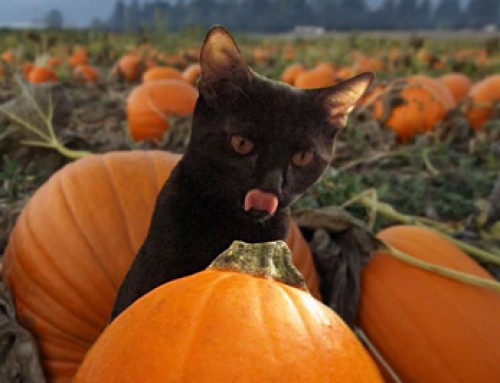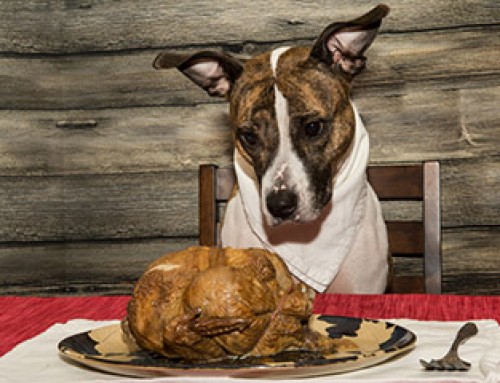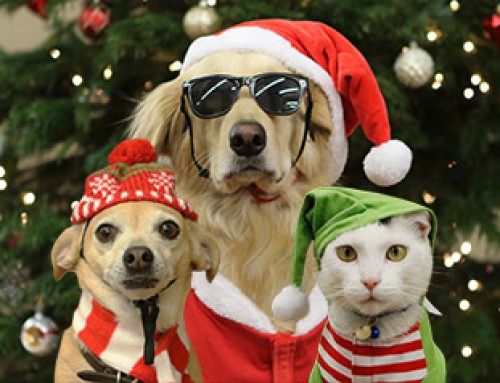 Easter is the season when chocolate and rabbits seem to pop up everywhere! In addition to chocolate, Easter presents an additional set of risks for your pets, including certain plants, fatty foods, decorations, Easter baskets, egg hunts, picnics, parties, and parades. Thousands of pets become injured or sick each year thanks to the unforeseen dangers of this colorful holiday. But with a little knowledge and effort, you can keep your celebrations pet-safe.
Easter is the season when chocolate and rabbits seem to pop up everywhere! In addition to chocolate, Easter presents an additional set of risks for your pets, including certain plants, fatty foods, decorations, Easter baskets, egg hunts, picnics, parties, and parades. Thousands of pets become injured or sick each year thanks to the unforeseen dangers of this colorful holiday. But with a little knowledge and effort, you can keep your celebrations pet-safe.
Chocolate Can Be Deadly

Chocolate is the food for lovers, but it is very toxic to dogs and cats. A small amount can cause serious—and perhaps fatal—consequences. Chocolate contains methylxanthine alkaloids in the form of theobromine and caffeine, which cause constriction of arteries, increased heart rate, and central nervous system stimulation. This can lead to vomiting, diarrhea, restlessness, and increased urination, and can eventually cause excitability, increased respiration and heartbeat, stiffness, seizures, and exaggerated reflexes. Certain types of chocolate contain higher amounts of this alkaloid; baking chocolate has the highest level while white chocolate has the lowest. A potentially lethal dose in a 15-pound dog is only one pound of milk chocolate. Cardiac failure, seizures, coma, and even death can occur if your pet is not treated within four to six hours after ingestion. Following are the toxicity levels of different types of chocolate:
- Baking chocolate. This type of chocolate has the highest concentration of theobromine and caffeine. Therefore, pets only need to ingest a small amount to cause serious illness or even death. Mild signs of toxicity occur when only 0.1 ounces per pound of body weight is ingested. Severe signs occur with 0.3 ounces per pound of body weight. A 10-pound cat or dog would need to ingest only one ounce of baking chocolate to cause toxicity.
- Semi-sweet chocolate/instant cocoa. Mild signs of toxicity can occur when ⅓ ounce per pound of body weight is ingested. Severe signs occur when 1 ounce per pound of body weight is eaten. A 10-pound cat or dog would only need to ingest 3 ounces of either semi-sweet chocolate or instant cocoa to cause toxicity.
- Milk chocolate. Mild signs of toxicity can occur when 0.7 ounces per pound of body weight is ingested. Severe signs occur with 2 ounces per pound of body weight. A 10-pound cat or dog would need to ingest 7 ounces of milk chocolate to cause toxicity.
- White chocolate. This has the lowest form of toxicity because it contains the least amount of theobromine. Mild signs can occur with the ingestion of 45 ounces per pound of body weight. Severe toxicity occurs when 90 ounces per pound of body weight are ingested. This means that a 10-pound cat or dog would need to ingest 27 pounds of white chocolate to cause a severe problem. Of course, it’s unlikely for such a thing to happen, but you never know.
Look Out For Lilies

Every year cat owners bring beautiful lilies into their homes, unaware of the tragedies that await. Cats are curious creatures, and hundreds of them get violently sick and even die from exploring and ingesting these delicate, traditional Easter flowers. Lilies that are toxic to cats include the Easter lily (Lilium longiflorum), Tiger lily (Lilium tigrinum), Rubrum lily (Lilium speciosum), Japanese show lily (Lilium lancifolium), and some species of the Day lily (Hemerocallis species). All parts of these lily plants are considered toxic and can cause kidney failure and death in cats. (At this time, no toxicity has been reported in dogs.) Within only a few hours of ingesting even a small amount of these plants, cats may vomit, become lethargic, and stop eating. Without veterinary care, this quickly progresses to life-threatening kidney failure in 36 to 72 hours. The best way to avoid lily toxicity is to keep these plants in a separate room away from nibbling cats or bring home a safer alternative, such as Easter orchids, Easter cactus, Easter daisies, or violets.
Fatal Foods
 Holiday foods are meant for people, not pets! Ham, for instance, is very dangerous for cats and dogs. In addition to being high in fat, ham is also very salty and can cause serious stomach upset or pancreatitis (see “Toxic turkey” section under Thanksgiving). Pets will climb counters and get into the trash for a taste of that rich holiday meal. Be sure to freeze the carcass, including the bones, and avoid leaving ham sitting on a counter where your pets may be able to reach it. In addition, ham and other meats may come packaged with string wrapped around them. When you remove the string, tie it up in a plastic bag and dispose of it outside in the trash can immediately. Pets may swallow the tasty packaging, which can be disastrous.
Holiday foods are meant for people, not pets! Ham, for instance, is very dangerous for cats and dogs. In addition to being high in fat, ham is also very salty and can cause serious stomach upset or pancreatitis (see “Toxic turkey” section under Thanksgiving). Pets will climb counters and get into the trash for a taste of that rich holiday meal. Be sure to freeze the carcass, including the bones, and avoid leaving ham sitting on a counter where your pets may be able to reach it. In addition, ham and other meats may come packaged with string wrapped around them. When you remove the string, tie it up in a plastic bag and dispose of it outside in the trash can immediately. Pets may swallow the tasty packaging, which can be disastrous.
Never give your pets alcoholic beverages or table scraps of any kind. Instead, give them their regular food, treats, and lots of love. Never give your pet leftover bones from meals you are making. Ingested bones can splinter and be fatal. Educate visitors and guests on the dangers of giving table scraps to your pets. Many non-pet owners are simply unaware of the risks of giving bones to cats or dogs.
Don’t leave candy out. Lots of animals love the sweet smell and taste of candy and will stop at nothing to ingest it. Cats also have a tendency to play with round candies, setting up a potential choking hazard.
Deadly Decorations
 I can’t tell you how many times I’ve treated pets at the emergency clinic for eating decorations. What we see as festive and decorative our pets see as interesting and edible. All parts of basket décor are dangerous. This includes plastic grass, plastic toys, and candy (foil wrapper and all). Easter grass looks like real grass and pets can’t always tell the difference. Once ingested, these objects can become lodged in the stomach or intestines, requiring abdominal surgery to remove them. Pets can also choke on these items, so be sure to keep Easter baskets out of reach.
I can’t tell you how many times I’ve treated pets at the emergency clinic for eating decorations. What we see as festive and decorative our pets see as interesting and edible. All parts of basket décor are dangerous. This includes plastic grass, plastic toys, and candy (foil wrapper and all). Easter grass looks like real grass and pets can’t always tell the difference. Once ingested, these objects can become lodged in the stomach or intestines, requiring abdominal surgery to remove them. Pets can also choke on these items, so be sure to keep Easter baskets out of reach.
Ribbons, bows, streamers, and other decorative items are all subject to being chewed or played with and eaten. Never put ribbons or bows around pets’ necks. Many animals have been accidentally strangled as a result of this innocent gesture.
Note: If you suspect your pet has eaten something foreign, take them to the vet right away. Don’t wait until signs of vomiting, loss of appetite, abdominal pain, drooling, or abnormal bowel movements occur. At that point your pet will be in much greater danger than if had you taken them in right away. You’ll not only save money by acting immediately, but you may also save your pet’s life.
Easter Bunny Backlash
 Pets often include themselves in the Easter egg hunt. Unfortunately, they often find the forgotten rotten egg that, if ingested, can lead to serious food poisoning. Be doubly sure to keep track of all hidden eggs and baskets.
Pets often include themselves in the Easter egg hunt. Unfortunately, they often find the forgotten rotten egg that, if ingested, can lead to serious food poisoning. Be doubly sure to keep track of all hidden eggs and baskets.
Do not run out and get a rabbit, chick, or any new pet during Easter. Such impulse buying is a mistake. Purchasing a new pet should only be done after careful consideration and research as to what it takes to own one of these soft, lovable creatures. Granted, they are cute, but you have to take into account the added responsibility financially, emotionally, and physically. Every year shelters across America are flooded with unwanted pets post-Easter by people who didn’t think ahead.
Guests Galore
 While many people enjoy entertaining guests, having parties, or changing their routine, most pets shy away from such things. If you are having guests over, put your pets in a spare room with some toys and a comfortable place to lie down. Playing soft music will help them relax. Pets that have their own room will feel safer and less stressed, and won’t be able to accidentally escape out the front door or get table scraps from visitors. Try to keep them on their regular schedule for feeding and exercise. Give your pets plenty of attention so they don’t feel left out, and make sure they have a current ID tag on at all times. This is important throughout the year, but especially during the holidays, as there is a greater risk of your pet escaping when there are more visitors around.
While many people enjoy entertaining guests, having parties, or changing their routine, most pets shy away from such things. If you are having guests over, put your pets in a spare room with some toys and a comfortable place to lie down. Playing soft music will help them relax. Pets that have their own room will feel safer and less stressed, and won’t be able to accidentally escape out the front door or get table scraps from visitors. Try to keep them on their regular schedule for feeding and exercise. Give your pets plenty of attention so they don’t feel left out, and make sure they have a current ID tag on at all times. This is important throughout the year, but especially during the holidays, as there is a greater risk of your pet escaping when there are more visitors around.
By Karen “Doc” Halligan





Follow